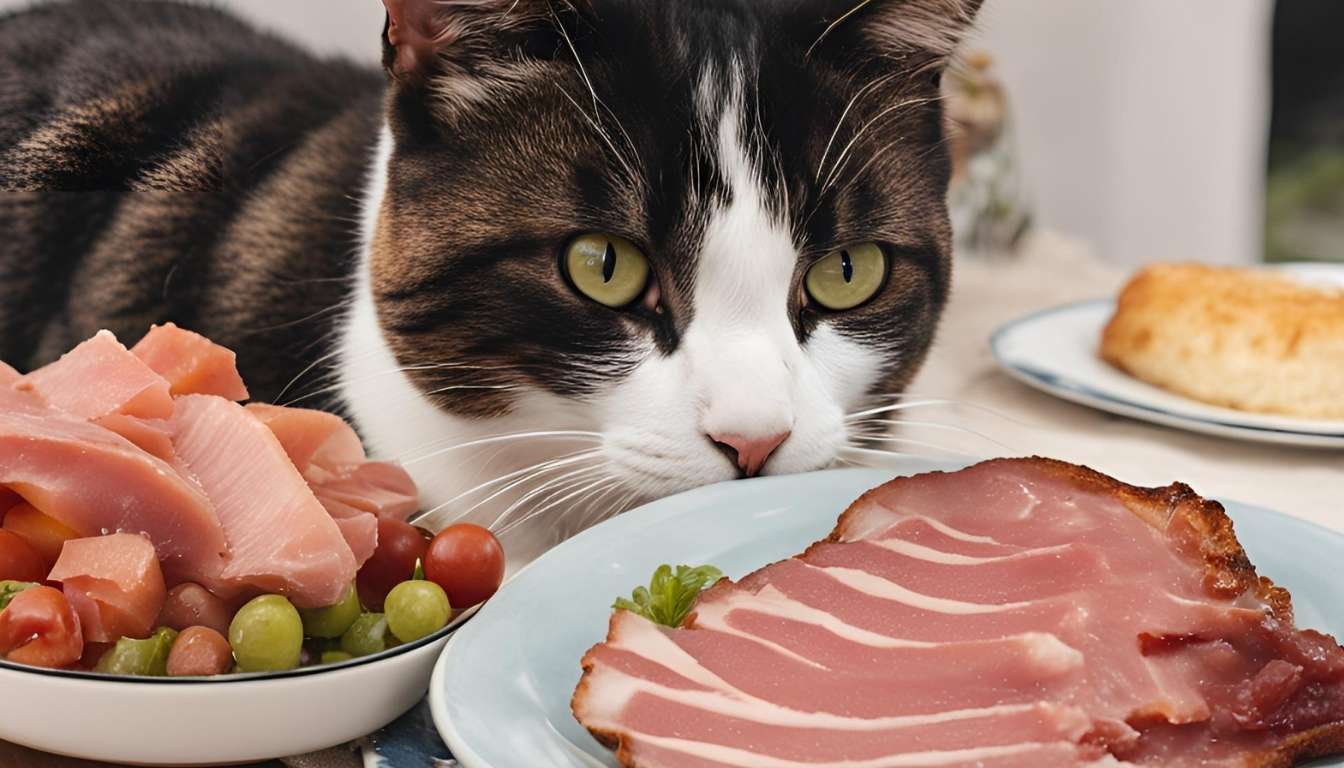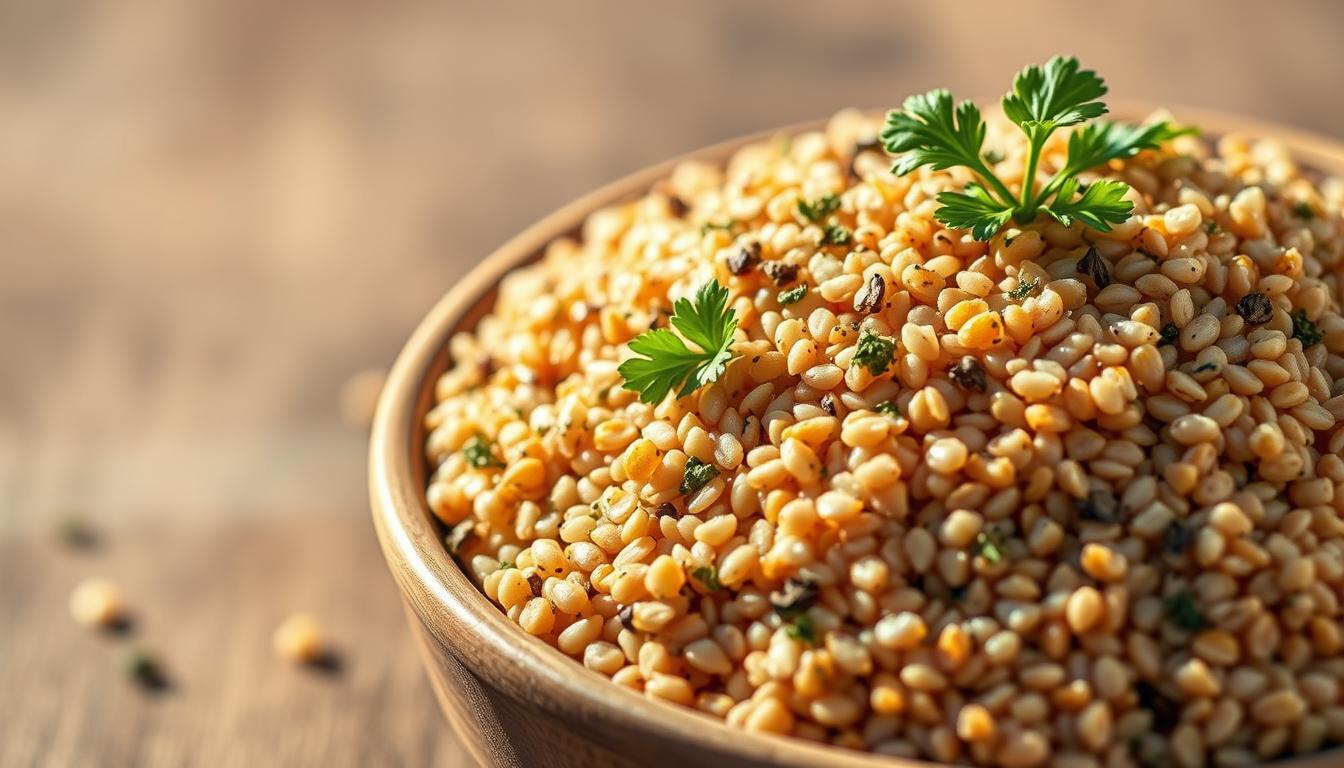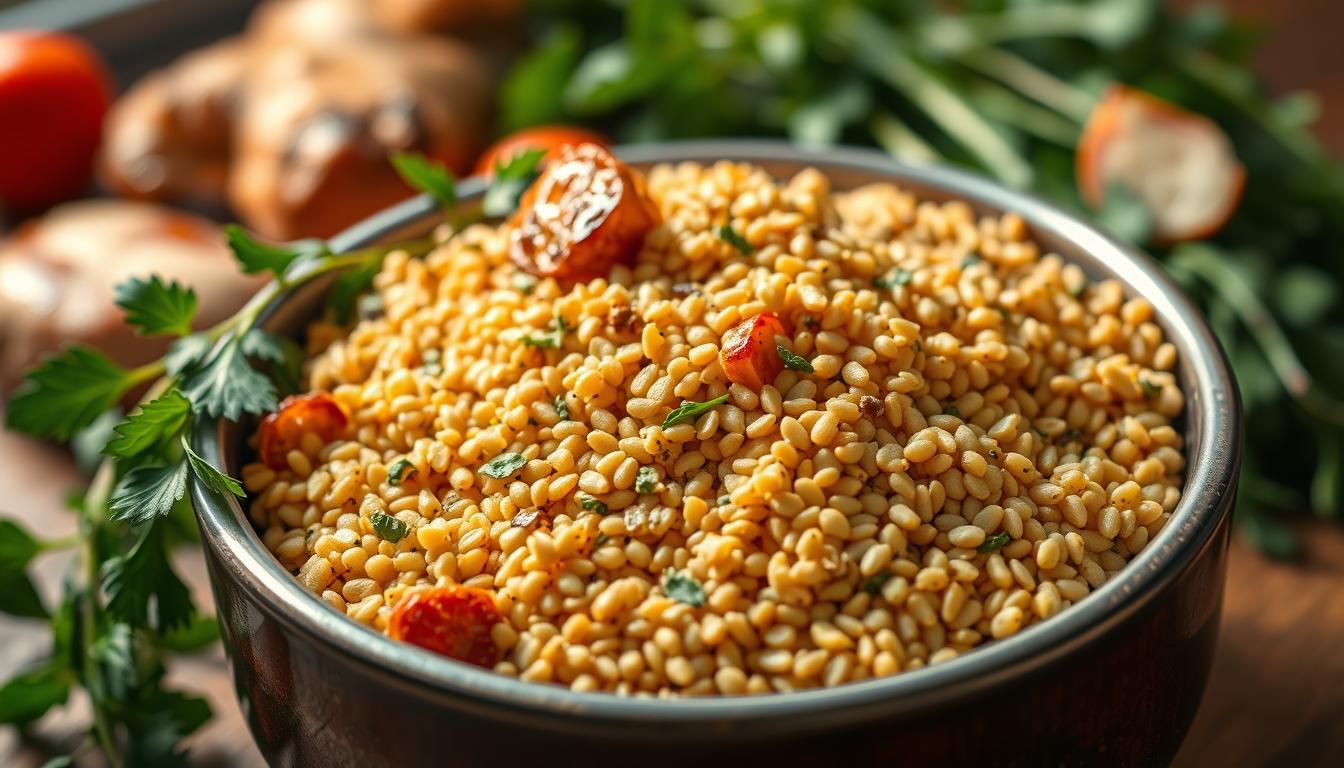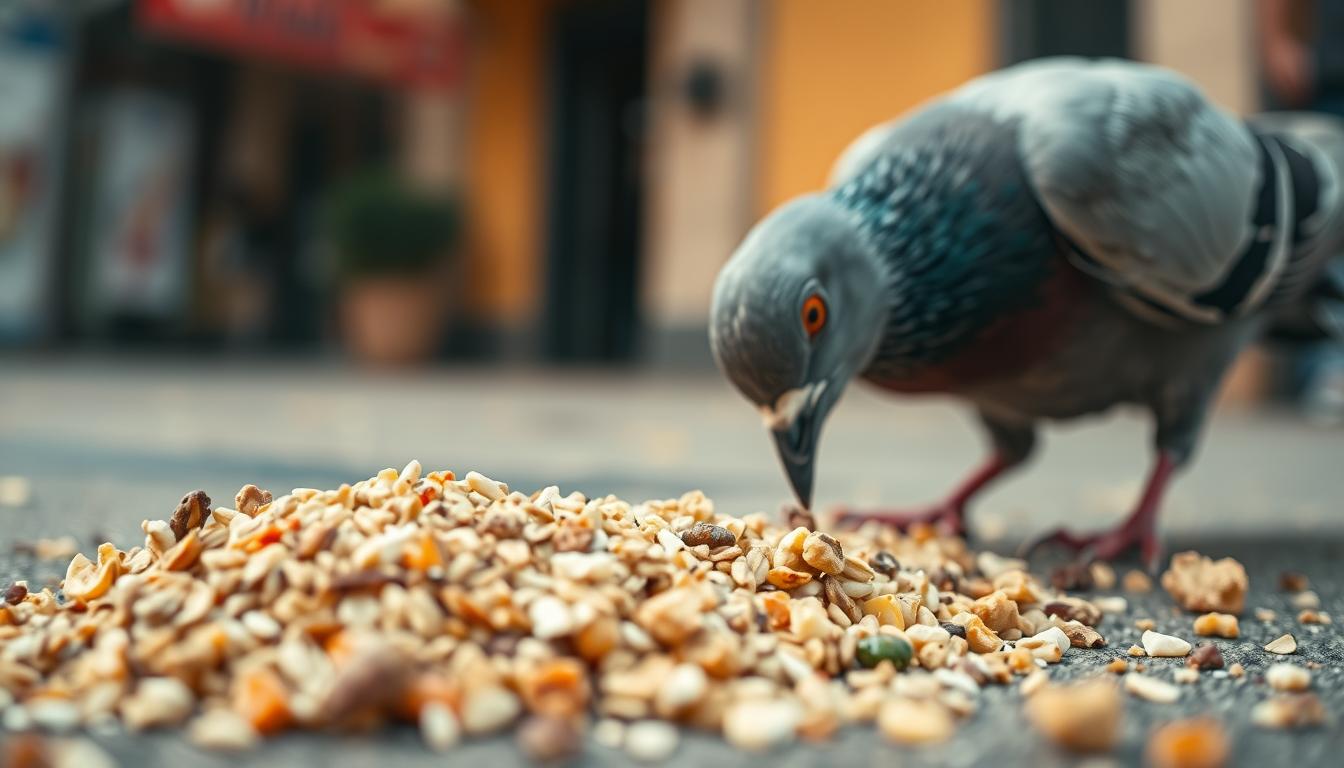Have you ever found yourself in the kitchen, slicing a juicy ham, and wondered, “Can cats eat ham?” While ham might seem like a harmless treat for your feline friend, there are some surprising risks to consider.
As natural meat-eaters, cats are drawn to protein-rich foods like ham. However, this popular holiday staple isn’t as straightforward as it seems. Ham can offer some benefits, but it also comes with significant risks that every cat owner should understand.
Ham is a favorite in many households, and your cat might be tempted by its savory aroma. But before you share that slice, it’s important to think carefully. This article will explore three alarming reasons to be cautious about feeding ham to your cat. We’ll dive into its nutritional benefits, proper preparation methods, and the safety precautions you need to take.
You’ll learn when ham can be an occasional treat and when it might endanger your cat’s health. By the end of this article, you’ll have a clear understanding of how to make informed decisions about sharing ham with your pet.
Table of Contents
Do Cats Eat Ham: What You Need to Know
Ham can be tempting for your cat due to its strong aroma and high protein content. However, it’s crucial to understand the risks involved. Processed ham is often high in salt and preservatives, which can be harmful to your cat’s health.
The Appeal of Ham as a Feline Treat
Cats are naturally drawn to protein-rich foods like ham. The savory smell and taste make it an appealing treat. However, it’s important to consider the ingredients and risks, such as high sodium content.
Understanding Feline Dietary Needs
While ham can be an occasional treat, it shouldn’t replace your cat’s regular, nutritionally complete cat food. Even small amounts of ham can disrupt the balance of your cat’s diet, leading to potential health issues.
Ham is high in salt, which can lead to serious health problems for cats. Moderation is key, and you should only offer ham in very small amounts. Always choose plain, unprocessed ham to minimize the risk of harmful additives.
Remember, your cat’s diet should primarily consist of high-quality cat food that meets their nutritional needs. Ham can be an occasional treat, but it should never make up more than a tiny portion of their meals.
Nutritional Benefits and Risks of Ham for Cats
Ham can be a nutritious yet risky addition to your cat’s diet. While it offers essential nutrients, its high sodium and preservative content pose significant health concerns.
Exploring the Nutrient Profile of Ham
Ham is rich in protein, making it appealing for cats as obligate carnivores. It also contains beneficial nutrients like Vitamin B6, selenium, zinc, and iron, which support immune function and overall health. However, these benefits come with drawbacks.
Health Concerns: Sodium, Preservatives, and More
The high sodium in ham can lead to hypertension and kidney issues in cats. Preservatives common in processed ham further increase health risks. While ham can be an occasional treat, it should never replace a balanced, complete cat food diet.
When considering ham for your pet, opt for plain, unprocessed varieties to minimize sodium and additives. Even then, portion control is crucial. Unlike dogs, cats have stricter dietary needs, making careful consideration essential.
How to Safely Incorporate Ham into Your Cat’s Diet
Feeding your cat ham can be a delicate balance. While it might seem like a tasty treat, ensuring it’s done safely is crucial for your pet’s health. This section will guide you on how to prepare ham safely and determine the right serving size for your feline friend.
Proper Preparation and Cooking Methods
When preparing ham for your cat, it’s best to cook it at home. This ensures it’s free from additives found in deli meats. Opt for unseasoned ham to avoid harmful preservatives and excessive sodium. Cooking ham thoroughly is essential to eliminate bacteria like salmonella, which can be harmful to cats.
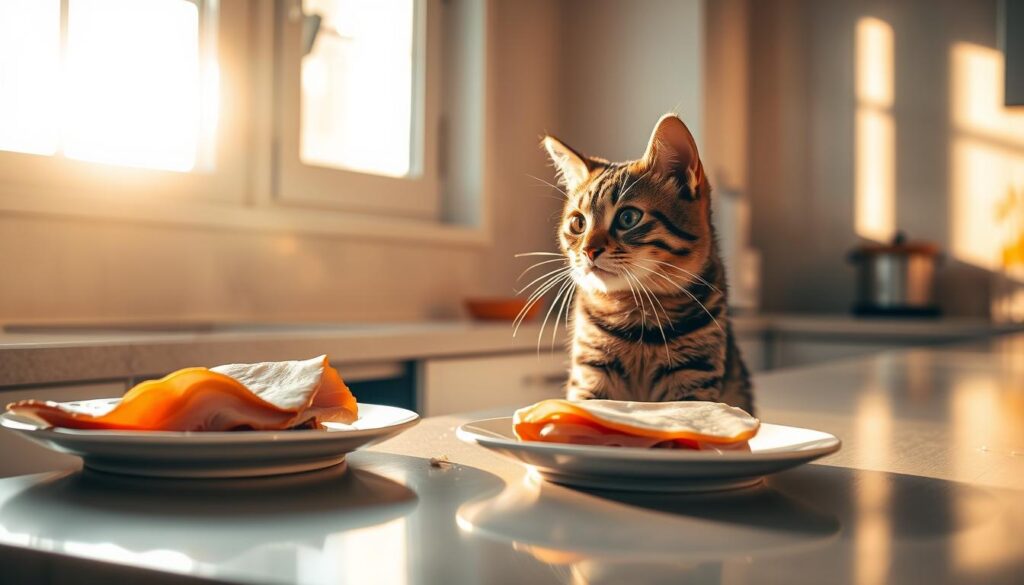
Seasonings and preservatives, often found in processed ham, can upset your cat’s digestive system. Therefore, it’s important to keep the ham plain and unflavored.
Determining the Right Serving Size
Serving size is critical when feeding ham to your cat. As a general rule, ham should only make up a small portion of your cat’s diet. For adult cats, ham can be an occasional treat, but for kittens with delicate systems, moderation is key.
Consider cutting ham into small cubes to prevent choking and monitor portion sizes closely. This approach helps ensure your cat enjoys the treat without risking overindulgence.
Remember, your cat’s diet should primarily consist of high-quality cat food that meets their nutritional needs. Ham should only be an occasional treat and never a staple.
Special Considerations for Kittens
Kittens are at a critical stage of growth, and their dietary needs are far more sensitive than those of adult cats. As a responsible pet owner, it’s crucial to understand how treats like ham can impact their development.
Avoiding Dietary Imbalances in Young Cats
Kittens require a diet rich in specific nutrients to support their rapid growth and development. While ham can seem like a harmless treat, it may not provide the balanced nutrition they need. High in phosphorus, ham can disrupt the delicate calcium balance essential for healthy bone development. Even small amounts can lead to dietary imbalances that affect overall health.
Risk Factors for Kittens with Delicate Digestive Systems
Young cats are prone to digestive issues, and introducing ham can exacerbate these problems. The high sodium content in ham can lead to dehydration and electrolyte imbalances, which are particularly dangerous for kittens. Additionally, the preservatives found in processed ham can cause stomach upset and diarrhea.
“A balanced meal is not just about adding variety; it’s about ensuring every nutritional need is met without compromise.”
While a tiny piece of plain, unprocessed ham might not immediately harm your kitten, it should be an extremely rare treat. Kittens thrive on a consistent, nutritionally complete diet specifically formulated for their life stage.

- Offer kitten-specific treats recommended by your veterinarian.
- Ensure their main meals are high-quality, nutrient-rich kitten food.
- Always consult with your vet before introducing any new foods.
Remember, your kitten’s health depends on the choices you make today. Always prioritize a balanced, complete diet over tempting treats like ham.
Alternatives and Balanced Diet Options for Your Feline Friend
While ham can be an occasional treat, it’s important to focus on providing a balanced and nutritious diet for your cat. Exploring alternative protein sources and understanding the elements of a complete meal can help ensure your pet’s overall health and well-being.
Exploring Other Protein Sources for Cats
Cats thrive on a variety of protein-rich foods. Consider these alternatives:
- Chicken: A lean protein source, rich in essential amino acids.
- Turkey: Similar to chicken, it’s low in fat and high in nutrients.
- Fish: Provides omega-3 fatty acids for skin and heart health.
- Beef: Offers a higher protein content, though it can be fattier.
These options are easier to balance in a complete diet compared to ham, ensuring your cat gets the nutrients they need without the risks associated with processed meats.
The Importance of a Complete, Balanced Meal
A balanced diet is crucial for maintaining your cat’s health. It should include:
- High-quality protein to support muscle growth and energy.
- Vitamins and minerals for immune function and overall health.
- Omega-3 fatty acids to promote skin and coat health.
A complete meal ensures your cat’s dietary needs are met, supporting everything from digestion to heart health.
By focusing on these alternatives and ensuring a balanced diet, you can keep your cat healthy and happy. Remember, treats like ham should never replace a nutritionally complete cat food.
Conclusion
In the world of pet care, understanding what your cat should and shouldn’t eat is crucial. While ham might seem like a harmless treat, it’s important to approach it with caution. As discussed, ham offers some nutritional benefits but comes with significant risks, especially due to its high sodium content and preservatives.
For adult cats, ham can be an occasional treat if prepared properly—plain, unprocessed, and in small amounts. However, for kittens, it’s best to avoid ham altogether due to their sensitive digestive systems and developmental needs. Always prioritize high-quality, balanced cat food as the main staple of their diet.
Before making any changes to your cat’s diet, consult with your veterinarian for personalized advice. Remember, a balanced and nutritious diet is the heart of your cat’s health. Explore more resources on cat nutrition to ensure your pet leads a happy and healthy life.
FAQ
Can cats eat ham safely?
While cats can technically eat ham, it’s important to approach with caution. Ham is high in sodium and preservatives, which can be harmful in large amounts. Always opt for unseasoned, cooked ham and serve it in moderation.
What are the risks of feeding ham to cats?
Feeding ham to your cat can lead to health issues like kidney strain and blood pressure problems due to high sodium content. It’s also important to avoid any ham with added salt or preservatives.
How much ham can I safely give my cat?
The amount of ham you can give your cat should be very small—no more than a few bites occasionally. Overfeeding can disrupt their balanced diet and lead to nutrient imbalances.
Is ham a good source of protein for cats?
While ham does contain protein, it’s not a complete or ideal meat source for cats. It lacks essential nutrients like taurine and can be too high in sodium. Stick to high-quality cat food for their protein needs.
Can kittens eat ham?
Kittens should avoid ham altogether. Their delicate digestive systems are easily upset by high sodium and preservatives. Focus on nutrient-rich kitten food for their growth and development.
What are better alternatives to ham for cats?
Consider offering plain, cooked chicken or turkey as a treat. These are lower in sodium and richer in the nutrients your cat needs. Always choose unseasoned options to ensure safety.
How can I ensure my cat’s diet is balanced?
Stick to a high-quality cat food that meets your pet’s nutritional needs. If you want to add variety, consult your veterinarian for safe and healthy treat options. Avoid making ham or other human foods a regular part of their diet.
Source Links
- Can Cats Eat Ham? Why Ham Isn’t the Best Choice for Your Little Carnivore – https://www.yahoo.com/lifestyle/cats-eat-ham-why-ham-060000590.html
- Woman comes home, can’t believe what mom is feeding cat “in this economy” – https://www.newsweek.com/woman-comes-home-cant-believe-mom-feeding-cat-economy-1980455
- Blog & News – https://www.foodfurlife.com/blog–news.html
- Keep Your Cat Safe—Why Ham Is Not the Best Treat – https://www.thesprucepets.com/can-cats-eat-ham-8736310
- Ham for Cats: Safe or Risky? Nutrition Guide | Bailey’s CBD – https://baileyscbd.com/blogs/cat-nutrition/ham-and-cats-dietary-considerations?srsltid=AfmBOoojczdc7HHFI1OYK8WLIFvYRNLZU6-WZ0RDmA19wQlOV46eRa3-
- Can Cats Have Ham? – https://basepaws.com/cat-insider/can-cats-eat-ham
- Ham for Cats: Safe or Risky? Nutrition Guide | Bailey’s CBD – https://baileyscbd.com/blogs/cat-nutrition/ham-and-cats-dietary-considerations?srsltid=AfmBOorkwaDCjKEH1thAwRChty9Yi5n4U11cTOYuSJMifb_s0-CxyWS3
- Can Cats Eat Ham | Tips for Feeding Cats Ham Safely – https://felinefancy.co.uk/blogs/cat-care-tips/can-cats-eat-ham?srsltid=AfmBOoogeFtghph6LtDiKFXATgk34bbwF0no7g0YMDOZzvK3pT3mBLql
- Can Cats Eat Ham? Exploring The Risks Of Processed Meats | Cat Boarding Hotel Laguna, Mission Viejo, Anaheim, Santa Ana, CA | Cats Luv Us – https://www.catsluvus.com/cat-food/can-cats-eat-ham-exploring-the-risks-of-processed-meats/?srsltid=AfmBOoppzqXZEZPG-WRJrhBXuhWcuUtXvGIO7npEoRibjWdDjknlvrWw
- Ham for Cats: Safe or Risky? Nutrition Guide | Bailey’s CBD – https://baileyscbd.com/blogs/cat-nutrition/ham-and-cats-dietary-considerations?srsltid=AfmBOooYd5yPoSibtxPhyHtYJL2tLRq9BTFxLpToQc2btpVaSfCLKF0T
- 13 Holiday Foods That Are Dangerous to Cats – https://www.petmd.com/cat/nutrition/holiday-foods-dangerous-to-cats
- Can Cats Eat Ham? Exploring The Risks Of Processed Meats | Cat Boarding Hotel Laguna, Mission Viejo, Anaheim, Santa Ana, CA | Cats Luv Us – https://www.catsluvus.com/cat-food/can-cats-eat-ham-exploring-the-risks-of-processed-meats/?srsltid=AfmBOopZYluF83QDtncOsBP0KecvSbaQelvpIgW-l93mM5xHE7dTx26b
- How Long Cats Can Go Without Food And When To Be Concerned, According To A Vet – https://www.southernliving.com/food/how-to/how-long-can-a-cat-go-without-eating?srsltid=AfmBOopaKvoZkZV8g7XnPjEjDmQXOuSjPN8TjDZMrFQbtjZigfQKgITC
- Can Cats Eat Ham | Tips for Feeding Cats Ham Safely – https://felinefancy.co.uk/blogs/cat-care-tips/can-cats-eat-ham?srsltid=AfmBOoodR92AKa9UOSDwVZm52fQs9QXzs6FlG3VXZiTLJ4KSWt_5TDBu
- Ham for Cats: Safe or Risky? Nutrition Guide | Bailey’s CBD – https://baileyscbd.com/blogs/cat-nutrition/ham-and-cats-dietary-considerations?srsltid=AfmBOoo3flTBAc9Qxv93N5gVX0P2CCD-pM9492fVAl_6wCb3b_3J9-n7
- Can Cats Eat Deli Meat? Exploring The Safety Of Processed Meats For Feline Consumption | Cat Boarding Hotel Laguna, Mission Viejo, Anaheim, Santa Ana, CA | Cats Luv Us – https://www.catsluvus.com/cat-food/can-cats-eat-deli-meat-exploring-the-safety-of-processed-meats-for-feline-consumption/?srsltid=AfmBOorezNpJi3o1zFNapoL7FRiZhVXiPAaFuWGmTNECgWf_wPNTkKxV
- 9 Human Foods That Cats Can Safely Eat: Vet-Reviewed Dishes – Catster – https://www.catster.com/nutrition/human-foods-safe-for-cats/
- Ham for Cats: Safe or Risky? Nutrition Guide | Bailey’s CBD – https://baileyscbd.com/blogs/cat-nutrition/ham-and-cats-dietary-considerations?srsltid=AfmBOoqa4RzB3wTQPuBE3bGDwc4Br_kpTBJdUWWunTVLscuTdRnP0DSg
- Can Cats Eat Ham? Exploring The Risks Of Processed Meats | Cat Boarding Hotel Laguna, Mission Viejo, Anaheim, Santa Ana, CA | Cats Luv Us – https://www.catsluvus.com/cat-food/can-cats-eat-ham-exploring-the-risks-of-processed-meats/?srsltid=AfmBOopiX7rMiHHwErY9mW-TNo6_VV7gSbZZ-0J0E8qoCVDYZ8kQ8Ag3
- Can Cats Eat Deli Meat (Lunch Meat)? Nutritional Facts & Safety Guide | Hepper – https://www.hepper.com/can-cats-eat-deli-lunch-meat/

